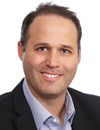Business Solutions
Expanding Your Sleep Network
The key to sleep therapy success is creating a constant stream of referrals.
- By Joseph Duffy
- Feb 01, 2017
 Sleep therapy continues to evolve as a competitive, difficult
business that offers HME providers considerable
revenue opportunity. The sleep market is growing, but
success depends on many factors, including diligent data
collection, favorable patient outcomes, keeping current
with technology and, like many other HME business categories,
traversing the volume of rules and regulations that continue to
challenge
the HME universe in general.
Sleep therapy continues to evolve as a competitive, difficult
business that offers HME providers considerable
revenue opportunity. The sleep market is growing, but
success depends on many factors, including diligent data
collection, favorable patient outcomes, keeping current
with technology and, like many other HME business categories,
traversing the volume of rules and regulations that continue to
challenge
the HME universe in general.
“Improved patient outcomes are, of course, key elements of a successful,
modern sleep business,” said Jon Yerbury, Vice President, Marketing,
Americas, ResMed. “But so too is the efficient management of resources
within HME providers that enables them to provide better patient care and
the ability to take on even more patients. Remote patient monitoring saves
HMEs significant time and labor, enabling them to focus on increasing referrals
a nd servicing more patients while providing the same quality of care.
In a 2015 report, Berg Insight reported that remote monitoring is growing
faster in the sleep therapy segment than in any other healthcare market.
The report projected that in 2016, sleep will surpass remote cardiac rhythm
monitoring, which has traditionally been the largest market segment.”
Sleep therapy provider Gary Sheehan, President and CEO, Cape Medical
Supply, Inc., an HME provider considered a sleep therapy pioneer, said his
company’s growth is “moderating,” but sleep therapy offers opportunities
for providers. Two of the biggest challenges Sheehan sees are rules and
regulations, which he said are impeding growth.
“Utilization management organizations are creating time delays and
Medicare’s audits have long since left the realm of reasonableness,” said
Sheehan. “The government needs to get back to focusing on if there was
a clinical need, was the product delivered and is the patient using and
benefiting from it. They have us chasing our tails for information and the
physician and lab communities are growing increasingly frustrated by all
that we are asking from them to simply get patients set up. It’s not a good
situation and we fail to understand who benefits from the environment they
are creating. It’s certainly not patient-centric and doesn’t support quality
outcomes in a timely fashion.”
With all these difficulties of maintaining a sleep business considered, a
sleep therapy provider must have exemplary company systems to overcome
these challenges in order to maintain and grow patient referrals, which are
the lifeblood of the sleep therapy business.
“There are many ways to grow the sleep business — d irect marketing
to sleep labs being the most important,” said Robyn Parrott, RRT,
President, Sleep Solutions Home Medical. “We incorporate social media,
emails and patient educational programs. Overall, 90% of our business
comes from referrals.”
Sheehan agreed with the importance of referrals: “Absolutely, referrals
are the only way to grow a sleep business.”
WHY REFERRAL DEVELOPMENT REMAINS SO CRUCIAL
Sleep Review’s first quarter 2016 sleep center survey results (bit.ly/2itlRQS)
indicate that sleep patient volume growth and per patient revenue are
growing, although not at the same clip as indicated in their last survey.
For example, the survey said that over the last 12 months of the Q1 2016
survey, average beds per respondent decreased slightly by 1 percent to
7.7 beds, but over the next 12 months, average beds per respondent are
expected to increase by 5 percent to 8.1 beds. Regarding patient growth,
respondents reported a patient volume growth of 6 percent over the last
12 months and expect a 6 percent growth over the next 12 months. These
patient growth figures show a slow down from 8 percent growth (over the
last 12 months) and 9 percent growth (over the next 12 months), according
to the Sleep Center’s last survey, released in third quarter 2015.
Yerbury said these recent findings demonstrate that the sleep business
is growing as it taps further into the undiagnosed patient population.
Educated sleep patients and the technology to diagnose and treat sleep
issues are creating more patient volume and thus the race for more referrals.
“There is broad awareness of sleep apnea and its impact on patients
health and community well being, and physicians and other healthcare
decision
makers across the care continuum continue to screen for it and
refer in for diagnostics where appropriate,” Sheehan said. “It’s still a
growing market, but not to the same degree it was a decade ago when
awareness was just beginning to come about. There is an opportunity
for providers who can work in a complex regulatory and reimbursement
provider and can put together a program that is closely monitored and
delivers strong outcomes for patients and healthcare professionals.
“There are innumerable barriers put in place by payers and it is increasingly
difficult to provide the right level of service and care to patients, in a
timely fashion,” he continues. “If you can construct a program, wrap a lot
of data around it, drive reporting to deliver visibility and stay on top of it as
it scales, it’s still a good line of business to be in. It’s not a place to dabble
and we still see providers who lack scale and sophistication trying to win
share and that creates a lot of bad outcomes for patients and a black eye
for an industry that can’t afford it.”
PERSPECTIVES ON DRIVING MORE REFERRALS
There are a variety of ways that providers can increase their stream of referrals.
To help sleep therapy providers capture referrals to grow their business,
HME Business tapped industry leaders, who in their own words offer
the following top tips for growing a sleep therapy patient referral base.
GARY SHEEHAN, PRESIDENT AND CEO OF CAPE MEDICAL SUPPLY INC.
 “Sleep therapy providers must have a strong direct sales force that is
in the field talking about the strengths of your program and working
collaboratively with your healthcare partners to drive compliant referrals,”
Sheehan says. “There is a lot of education that goes into generating
clean referrals and working to get patients set up timely given the overall
regulatory
environment.
“Sleep therapy providers must have a strong direct sales force that is
in the field talking about the strengths of your program and working
collaboratively with your healthcare partners to drive compliant referrals,”
Sheehan says. “There is a lot of education that goes into generating
clean referrals and working to get patients set up timely given the overall
regulatory
environment.
“Also, you need to be able to explain how you do what you do and
discuss the outcomes that doing it that way creates,” he continues.
“Through-putting compliant patients is the primary goal from a clinical
and business perspective — you need a process built to do that and a
team capable of communicating that to the referral population to drive
preference, traction and growth.
Sheehan adds that reporting is critical.
“We have an extraordinarily detailed reporting infrastructure and can
demonstrate to our partners compliance rates based on the RT that
performed the setup, the mask used, the payer, etc.,” he explains. “This
gives our partners confidence that their patients are with a high-quality
provider who has a depth of knowledge in the business line.
“Again, this is a highly complex business space and we continue to see
too many providers in it who don’t belong here — it’s not good for patients
health outcomes or the industry as a whole and I think some network
narrowing will likely be coming soon, particularly given the fact that there
is so much information available on outcomes and so much clinical utilization
data at our fingertips and at the payers’ fingertips,” he adds. “We
make a meaningful investment to drive compliance and are very proud of
our program and the results it creates. We win new business, very simply,
because we are better managers of our patients and their health outcomes
than the providers we compete with.”
This improves referral relationships, Sheehan adds. A provider’s partners
must know that it has its practice in order, and an effective way to accomplish
that is to use technology to measure and monitor each business step
and the infrastructure to make changes, he explains.
“Providers have to understand their sleep therapy practice from end to
end and have visibility into performance from the moment a referral hits
their system through when a patient is actively reordering supplies,” he
says. “What are your cycle times, throughputs, bottlenecks and volume challenges? If you cannot report regularly on these elements and report
them back to healthcare professionals and payers, sooner or later you will
be left behind. The ability to leverage data for decision making and growth
is an essential element of being a modern, innovative provider, and something
referral partners and payers will rightly come to expect.”
ANGELA GIUDICE, RPSGT, DIRECTOR OF CLINICAL SALES AND
EDUCATION, 3B MEDICAL INC.
 “Traditionally, HMEs secured referral sources by old-fashioned salesmanship
with a complement of donuts, coffee and luncheons in an effort to
build relationships,” Giudice, who stresses that is now changing.
“Traditionally, HMEs secured referral sources by old-fashioned salesmanship
with a complement of donuts, coffee and luncheons in an effort to
build relationships,” Giudice, who stresses that is now changing.
“At the end of the day, referral sources are primarily interested in the level
of care and support provided to their patients,” she says. “One way to drive
referrals is to demonstrate increased compliance with their patients. CPAP
therapy has a large drop off rate and an HME that can show their referral
sources concrete metrics of improvement likely develops an edge with the
referral. Demonstrating a willingness to go beyond the minimum necessary
(i.e., hosting patient therapy support meetings, patient educational forums,
etc.) demonstrates an HME provider’s commitment to sleep.”
Giudice also highlights staging patient education events as a key way to
foster strong relationships between providers, patients and referral partners.
“Patient feedback and word of mouth goes a long way to making [referrals]
feel comfortable with an HME company,” she says. “Hosting events,
such as A.W.A.K.E. meetings for PAP therapy gives patients a forum to
interact with HME and clinical staff and other sleep therapy patients. These
meetings encourage good faith between the patient and the HME company
playing host.”
JIM DOTY, SENIOR DIRECTOR, FIELD MARKETING NORTH AMERICA,
PHILIPS RESPIRONICS
 “For the vast majority of providers, physician referrals drive their sleep business,”
Doty says. “We hear the top ways to drive referrals are to support
each patient’s use and make life easy for the doctor’s staff. HMEs can
market themselves more valuably with their referral relationships and, in
doing so, can have greater patient management success.
“For the vast majority of providers, physician referrals drive their sleep business,”
Doty says. “We hear the top ways to drive referrals are to support
each patient’s use and make life easy for the doctor’s staff. HMEs can
market themselves more valuably with their referral relationships and, in
doing so, can have greater patient management success.
“Before we had connected solutions that let providers measure
patients’ adherence to therapy, referral sources would evaluate providers
simply on the service they provided to their office,” he continues. “While
this remains important, being able to know the specific patients who may
respond to therapy has increased intervention and has made providers
more efficient while also improving the number of patients who continue
to use therapy.”
When working with physicians, Philips Respironics hears that they like
to work with sleep providers who educate their patients thoroughly,
according to Doty.
“They often measure this via the number of patients who return to their
office asking questions about their therapy and about the percentage
of their patients who continue to use therapy following the 90-day trial
period,” he says. “By ensuring that patients understand each step of the
process, returning to the office can be minimized.”
Doty notes that, while the following items are not necessarily new steps,
providers should ensure execute they following with each patient:
The first time a patient is contacted for introductions and insurance
verification, explain the process steps and timing, as well as the financial
responsibilities. Be prepared to answer any questions they have about
OSA or therapy.
At the time of the initial instruction, engage the patient in a motivational
discussion and record what they tell you. Reminding them why they are
starting therapy may provide motivation later.
Take time to explain the therapy, as well as device use and cleaning. Have
the patient repeat the important points back to you so they have more
chance of remembering it later.
Use the patient’s use information to determine who may benefit from a
follow-up call and make calls as needed.
Initiate the calls or messages to support patient use and offer them
supplies as needed to support long-term use.
Run reports from adherence management software to report on
patients’ progress and use it to engage the referral source on the progress
of their patients.
Also Doty says providers should use a cloud-based data capture and
management system, such as his company’s EncoreAnywhere system so
that it can have current patient information and adherence rates, which they
can then report their to physicians.
ROBYN PARROTT, RRT, PRESIDENT OF SLEEP SOLUTIONS
HOME MEDICAL
 “Our company does a lot of tracking of numbers,” Parrott says.
“Quarterly, we review our mask refits to determine which are the best
masks that do not require a refit. We have found that the pillow system
mask requires the least amount of refits.”
“Our company does a lot of tracking of numbers,” Parrott says.
“Quarterly, we review our mask refits to determine which are the best
masks that do not require a refit. We have found that the pillow system
mask requires the least amount of refits.”
Also providers must track adherence, which Parrott stresses is much
different than compliance.
“Most DMEs are good at compliance but most are not good at adherence,”
she notes. “After one year of usage our adherence rate is at 73
percent, meaning 73 percent of our patients are still using and ordering
supplies. This is a good reference to market to the referral sources. We
also market our patient compliance rate, which is 86.2 percent.”
JON YERBURY, VICE PRESIDENT OF MARKETING FOR THE
AMERICAS FOR RESMED
 “A traditional way of building sleep referrals is to have dedicated sales
representatives who reach out to physicians, build relationships, discuss
patient needs and how your business can meet them. Providing your
referrals
with presentations and product brochures that they can give out
to their patients and have in their waiting rooms also helps solidify the
partnerships you’re building with them,” Yerbury says.
“A traditional way of building sleep referrals is to have dedicated sales
representatives who reach out to physicians, build relationships, discuss
patient needs and how your business can meet them. Providing your
referrals
with presentations and product brochures that they can give out
to their patients and have in their waiting rooms also helps solidify the
partnerships you’re building with them,” Yerbury says.
“Utilizing the latest in technology can help connect you to your
physicians
and drive referrals. Patient compliance and therapy management
systems, such as ResMed’s AirView, allow HME providers to link
physicians to their patients and provide them real-time access to patient
data in the cloud,” he continues. “This allows for better collaboration
between care providers, as well as office efficiencies and less reliance on
paperwork and faxing. HME providers should enter each of their referrals
into a patient management system, and ensure that they know how to log
in and access the data they need.
“It’s also important to proactively share patient compliance and
therapy data early with referrals,” he adds. “This ensures that they have
the reports they need and the ability to intervene or provide support for
patients who are struggling. Showing referrals when a patient is struggling
with their PAP pressure or high AHI, for instance, shows them that you are
a trusted and valuable partner in keeping patients on track and improving
their health outcomes.”
Providers should also help referral sources educate their patients can
help foster stronger relationships, according to Yerbury. He says sleep
businesses
should provide referrals with patient support information, such
as brochures, product displays and demonstration masks and devices.
He also highlights providing remote patient monitoring to referrals is
important.
“HME providers must have a robust patient compliance and therapy
management cloud-based software platform in order to show referral
sources patient outcomes,” he says. “Remote monitoring of patients’
therapy allows HMEs to quickly share with physicians when patients have
met compliance, and also highlights when therapy changes need to be
made, such as a comfort or pressure setting. Reports can be sent electronically
to referring physicians, or the referring physician can log in and access
the data themselves.”
In summary, Yerbury advises providers to focus on the following in order
to drive referrals:
A combination of therapies that benefit the vast majority of patients.
Education materials to physicians, sleep specialists and their patients to
help increase awareness of sleep apnea and referrals to your business.
Accessible and actionable data through connected care solutions that
efficiently monitor and help improve patient outcomes.
“From retail to HMEs, everyone is invested in creating good data and making
sure it offers good decisions — far beyond data for data’s sake,” he adds.
This article originally appeared in the February 2017 issue of HME Business.